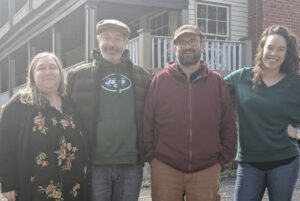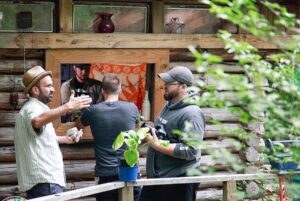Children’s television is a vast and varied arena — from trippy animations and puppetry to live-action comedy and educational content. There is a lot of room for creativity and innovation in the world of children’s programming. Chris Valluzzo realized that despite the variety in kids’ TV shows, a voice from Appalachia has been missing in the industry. And so “Penny P’s Backyard” was born out of a desire to highlight the incredible landscapes of Southwest Virginia and tell stories that present a unique intermingling between science and local art.
Art Meets Science
“I had a desire to create a children’s television show. I got the idea after finding an awesome location in Yellow Sulphur Springs, an old historic resort in Southwest Virginia. This was around fall of 2015. At the time, I just had this beautiful location and not much else,” Valluzzo, a multimedia producer and director at Virginia Tech’s Technology-enhanced Learning and Online Strategies, explained.
“Coincidentally enough, I was working at the university campus around the time when the Institute for Creativity, Arts, and Technology (ICAT) was coming to life, and I really liked the idea of a fusion between art and science. So I began noodling that concept — before that, I didn’t have much appreciation for the intersection of art and science,” he added.
Valluzzo received an ICAT Major SEAD grant to write the first season of “Penny P’s Backyard,” but the production of a full-fledged TV show is a time-consuming, labor-intensive process. “It’s already been a five-year process, and it will likely take another five years before we can get the show on air. We’re currently looking into streaming services in case they’d be interested in producing it. The show is about Penny P, an 11-year-old budding auteur, and her three best friends, Nelly, Ramp, and Sadie. They explore their vibrant Appalachian mountain community by creating short films about the exciting connections they discover between science, art, and culture.”

“Penny P and her three friends produce movies and animations about the world around them, and in doing so, they discover the connections between art and science, finding that the two seemingly different fields can share a common language. It is a fictional, episodic children’s television show that will be shot in the New River Valley,” Valluzzo explained,. “I wanted to create a children’s TV show, but I didn’t really want to have to leave Blacksburg to do it. So I wrote a show around where I live, and ICAT influenced the concept of art meeting science. That was the jumping-off point for me.”
Besides highlighting the beauty of New River Valley, parts of the show will be filmed on the Virginia Tech Blacksburg campus. The university will be facilitating production and consultations with faculty experts for the scientific portions of the show.
Dismantling stereotypes
“Penny P’s Backyard” highlights the beauty of Appalachia instead of playing into the usual stereotypes of the region. “There is a singular, stereotypical conception of Appalachia as this backward place that struggles with poverty, substance abuse, and lack of education. That’s like the single note you get about Appalachia. But really, if Appalachia is 10 things, that’s one of those. The other things that make up Appalachia are what the show is about. It’s about just being in Appalachia, living within its natural landscapes. We’re showing a different angle that is often ignored,” said Valluzzo.
Valluzzo was a student at Virginia Tech, where he took many Appalachian studies classes and graduated in 1998 with a degree in interdisciplinary studies from the College of Liberal Arts and Human Sciences. His background in documentary filmmaking is largely based on the culture and music of the region. “There are precious few things that the national media ever does to paint Appalachia in a positive light. I wanted to break that mold. This show gives a chance to people in New York City or Los Angeles and other countries of the world to learn about an area that they only hear negative things about. For me, getting to tell a positive story is a driving force behind making this show,” Valluzzo said, “And honestly, we’re not trying to say that Appalachia is devoid of any problems. But we want to start a discussion that good things happen here. There are good people who love their children. There is art and education and interesting stories here, and the region isn’t one homogenous area full of issues.”
“Penny P’s Backyard” takes concepts from art and science and finds the threads that tie them together, highlighting the value of interdisciplinary education and collaboration. “The story I’m trying to tell is that art and science have a shared language. The example I always use is, say, a geologist is talking about plate tectonics, and they would explain how the plates’ movement makes mountains form through complex interactions of heat and pressure. They would describe the bending and molding and folding of Earth. This led me to think that an artist who would use similar descriptions for their work would be a blacksmith. Blacksmiths use heat and pressure to create things out of earth and metal. So from there, I started looking at Appalachian art forms, and connected those with science,” Valluzzo said, “So in every episode, Penny and her crew make a film about a concept that ties together art and science to create a common language.”
Representation Matters
In a world where female filmmakers are rarely recognized and represented, “Penny P’s Backyard” matter-of-factly handles the topic of representation, and in the process seeks to inspire a new generation of filmmakers who value diversity. “It’s important to me to show children as filmmakers. I like the idea that this group of kids is just not making their way through life as normal kids do. We don’t write the show as if they’re on a play date — they actually set out to make short films and animations. And Penny is a female director, and that’s hard to come by in Hollywood. I think it’s incredibly important that there are young women who see Penny as a competent female director in charge of a film unit. We also introduce filmmaking terms and language through the dialogue in the show, so the kids who watch can actually pick up tips on making their own films. We want to inspire kids to go out and make movies, and maybe some of them will be really good at it in the future and become famous directors.”
Caring for The Natural Environment
Even when it comes to production, Penny P takes the road less traveled. Hollywood is the second highest polluter industry in the Los Angeles area, and Valluzzo has no intention to add to this environmental destruction, especially since the show will be shot in the ecologically important regions of Appalachia. “I’ve written 12 episodes of this show, and location scouting is going to be very easy for us. Every location that the script takes place in is a location I have seen. Appalachia is not just a background for the show, it actively shapes the story,” he said.
“Penny P’s Backyard” is a truly homegrown endeavor that utilizes local talent and all the good things that Appalachia has to offer. Valluzzo is particular about who he hires for the show — and makes sure that production does not add any extra pressure on the environment. “One of our big efforts is to make this show as environmentally sound as possible,” Valluzzo said, “I have hired some very competent freelancers in Roanoke and the broader East Coast. This will minimize traveling and ensure we have input from local talent.”

“We’ll be using solar power during production, and if we’re successful, we’ll accomplish one of the first productions using a majority of renewable energy. We’re not going to be building large studio sets. All the sets they build for indoor scenes in LA are thrown out later, nothing is recycled. They suck up so much electricity and all of that makes the film industry such a big pollutant,” Valluzzo explained, “It sounds a little crazy to take this approach but I believe that this show will make history once it goes on air because we will have done it in an environmentally friendly way that, frankly, Hollywood has the ability to do, but they don’t do it because it cuts into their profit margins.”
But for Valluzzo’s team, these costs are a given. They are not simply greenwashing, they are implementing strategies that are better for the environment from the get-go. The costumes will be sourced from YMCA and Goodwill, the locations will be all natural, and the episodes will be shot using renewable energy.
“Penny P’s Backyard” embodies the messages that it seeks to convey to its audience. From its very inception, the show has been about utilizing natural spaces and resources without causing any extra harm, and bringing the magic of art, science, and Appalachia to a broader audience. There is an exciting journey ahead for Valluzzo and his team.
Written by Aanila Kishwar Tarannum, graduate assistant for the VA Tech Institute for Creativity, Arts, and Technology.

